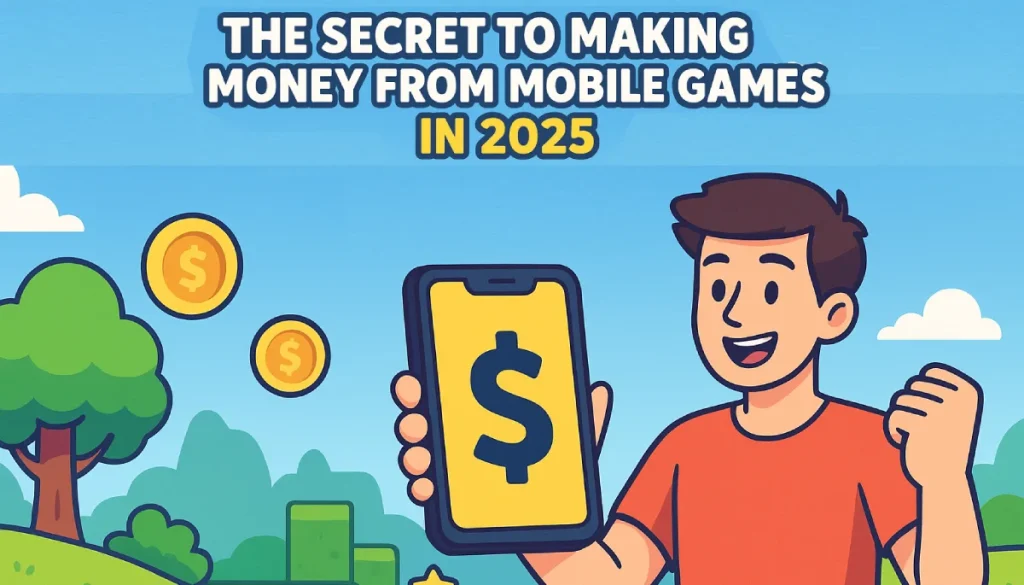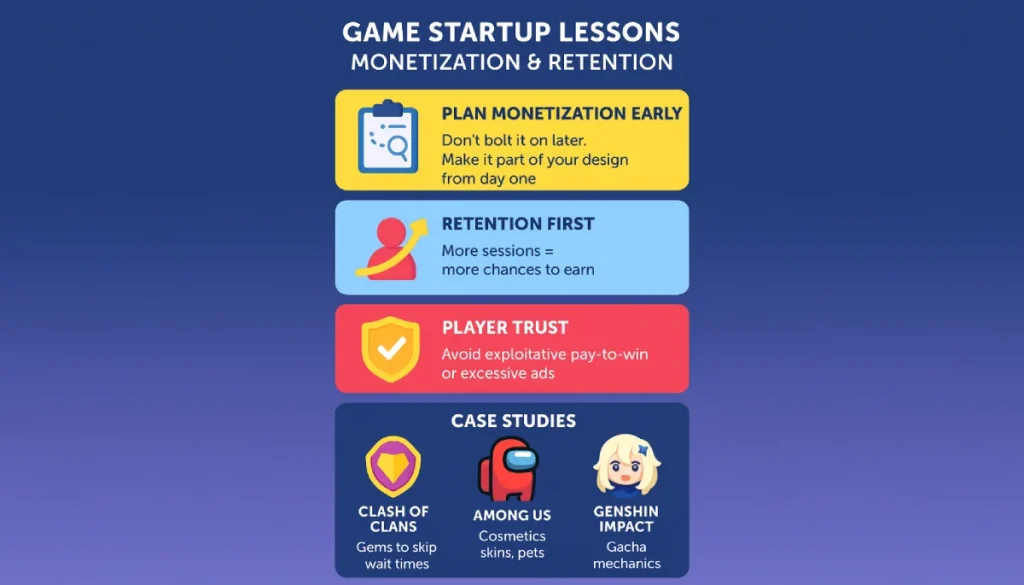
Is starting an indie game startup still profitable in 2025?
Yes. The indie game startup scene continues to grow because small studios can reach global audiences through app stores. Success depends on smart monetization, strong player retention, and offering a polished experience.
It has always required a combination of strategy and creativity to making money from mobile Games. The game industry is more competitive than ever in 2025, but it’s also more lucrative for innovators. If you know how monetization works, you can take advantage of a lot of opportunities whether you’re running a game startup or looking into becoming an independent game developer.
1. Why 2025 Will See a Boom in the Game Business
Mobile games are at the top of the game industry, which is currently valued at hundreds of billions of dollars worldwide. Because they appeal to players who are interested in strategy and entrepreneurship as well as those who want quick entertainment, casual and startup-themed games are particularly well-liked. Mobile provides the lowest entry barrier and the greatest potential reach for new developers, whether they are working for a small studio or an independent game startup.
Important Trends Affecting 2025 Mobile Game Monetization
- Hybrid Revenue Streams: Developers are no longer relying purely on one revenue model. Combinations of in-app purchases (IAP), ad revenue, subscriptions, and sometimes battle passes or season passes are increasingly normalized.
- Header Bidding & Programmatic Advertising: Better ad monetization through header bidding (allowing multiple ad networks to bid on ad slots in real time) is improving yield.
- AI / Automation & Personalization: Using AI to decide when to show ads, which users are likely to convert, what offers to display, etc., to reduce friction and boost revenue.
- Rising User Acquisition (UA) Costs: As more games compete, buying users is more expensive. Thus, retaining users, increasing lifetime value (LTV), and getting more revenue per user are more important than ever.
- Player Expectations & Experience: Players expect less intrusive monetization. Rewarded ads, optional IAPs, clean UX, and ethical transparency are important. Bad monetization can quickly kill retention. Reddit threads emphasize “tasteful monetization.”
2. Revenue Models: Making Money From Mobile Games
If you want to succeed in the game business game, your monetization model matters. The most effective methods in 2025 include:
How much money can a small developer realistically make?
It varies widely. A simple hyper-casual game might only generate ad revenue, while a well-designed mid-core or startup-themed title can earn significantly more through purchases and subscriptions. Many indie developers report steady passive income if their games retain players.
Here are the main models in use, with strengths, weaknesses, and when you should use them:
| Model | Strengths | Weaknesses | Best Use Cases |
|---|---|---|---|
| Free-to-Play + In-App Purchases (IAP) | Very scalable; high revenue potential if a small portion of users (whales) spend; works well in mid/hard-core games with depth. | Needs lots of content; risk of imbalance; can feel “pay-to-win” if misused. | RPGs, strategy, mid-core, simulation games; games with social/community features. Udonis notes many top games use IAP as primary income. |
| Ad-Based Models (rewarded video, interstitials, banners, native formats) | Monetize non-paying users; immediate revenue; good supplementary income. Rewarded ads are especially well received. | Risk of disrupting UX; can annoy users if overdone; ad revenue per user often low. Requires good volume. | Casual and hyper-casual games; free versions of games; games with frequent short sessions. |
| Subscriptions / Pass Systems | Steady recurring revenue; helps with forecasting; increases retention of engaged users. Tiered passes or VIP systems can offer value. | Requires delivering ongoing value; risk of churn; not every genre/player is willing to subscribe. | Mid-core games; social games; where you can provide continual updates, content, perks. |
| Freemium / Premium Upgrades | Gives users a taste before buying; can convert well if onboarding and value are clear. | Conversion rates often low; one-time purchases limit long-term revenue unless complemented by other streams. | Good for niche games or those with strong core gameplay and minimal but high quality features. |
| Battle Pass / Season Pass | Encourages regular engagement; predictable revenue per season; can tie content, cosmetics, challenges. | Content creation burden; balancing free vs premium tiers is delicate; players may burn out. | Games with social or competitive elements; games that can release regular content. |
3. Game Startup Lessons: Monetization & Retention
Running a game startup is much like building a startup company in real life: success depends on smart resource management, strong planning, and the ability to pivot when needed. Here are the core lessons every new developer should master:

1. Plan Monetization Early
Too many indie developers design a game first and think about monetization later often leading to clumsy, intrusive ads or rushed in-app purchase systems. The most successful game startups build monetization into the design flow from day one.
Case Study – Clash of Clans (Supercell)
- From the very start, the game was designed around “time-gated” mechanics (building upgrades take hours/days).
- Monetization (gems to skip wait times) feels natural rather than forced.
- Because it was planned early, the game balanced free-to-play progression with optional purchases.
Lesson: Think of monetization as part of your game loop, not an afterthought.
2. Retention First
Retention is the backbone of all game revenue. A high Day 1 (players returning after the first session) and Day 7 retention rate means your game has staying power. More sessions = more opportunities for ads, in-app purchases, or subscriptions.
Case Study – Among Us (InnerSloth)
- Launched in 2018 with little traction.
- Gained massive success in 2020 due to Twitch/YouTube exposure.
- Retention skyrocketed because of social gameplay and constant updates.
- Monetization through cosmetics (hats, skins, pets) worked because players were invested long-term.
Lesson: Focus on creating reasons for players to return — social play, daily missions, and fresh content. Monetization follows naturally when people stay engaged.
3. Player Trust
Players today are quick to abandon games that feel exploitative. Practices like aggressive paywalls, ad spam, or unfair advantages for paying users (“pay-to-win”) can destroy retention and brand reputation.
Case Study – Genshin Impact (HoYoverse)
- Uses gacha mechanics but balances them with free in-game rewards, events, and generous starter packs.
- Players trust the developers because updates are consistent, and free users can still progress meaningfully.
- Despite being free-to-play, the game grossed billions because players feel purchases are optional, not mandatory.
Counter-Example – Diablo Immortal (Blizzard/NetEase)
- Faced backlash at launch for aggressive monetization.
- Community perception of “pay-to-win” hurt its reputation, even though it earned strong initial revenue.
Lesson: Ethical monetization offering cosmetic or optional upgrades instead of forcing payment for progression builds long-term loyalty.
4. Community Feedback & Iteration
Modern indie game startups thrive by listening to players and adapting quickly. Reddit, Discord, and in-game surveys give insights into what frustrates users and what they’re willing to pay for.
Case Study – Stardew Valley (ConcernedApe)
- Single-developer indie success story.
- No ads, no microtransactions one-time purchase only.
- Developer kept updating the game with community-requested features, boosting retention and sales across multiple platforms.
Lesson: Even if your monetization is light, community trust + long-term support can turn a small indie title into a global success.
Takeaway for Game Startups:
- Plan monetization into your design from day one.
- Focus on retention with fresh content, social hooks, and progression systems.
- Build player trust with fair, ethical monetization.
- Stay flexible — community-driven updates can transform your game’s success.
4. Why Business Simulation Games & Startup Games Work
One of the fastest-growing niches in mobile is management and startup-themed games. They blend entertainment with strategic decision-making, allowing players to build virtual companies, manage resources, and grow empires. Many successful titles in this genre rely on hybrid monetization free-to-play models combined with optional upgrades, subscriptions, or cosmetic purchases.
For small studios and indie game startups, this space is appealing because it usually requires lower production budgets, has highly engaged communities, and offers strong replay value. Players often return again and again, driven by the desire to see how far their virtual businesses can grow.
5. Scaling Your Indie Game Startup
For indie developers dreaming of building the next hit:
- Focus on a Niche: Instead of competing with giants, aim for business start up games, management sims, or other underserved genres.
- Leverage Community: Reddit and Quora discussions reveal that players value dev transparency. Early feedback can shape monetization without backlash.
- Hybrid Strategy: Use ads for free users, premium passes for committed players, and IAP for those who want extras.
- Think Global: Localize your game startup for different regions. Pricing and ad yields vary by market.
Do players still spend on mobile games in 2025?
Absolutely. Global spending is at an all-time high, especially in mobile. Players are more willing to support games that are transparent, fair, and fun
6. Wrapping Up: Strategy for Profit & Longevity
The key to making money from games in 2025 is combining ingenuity, astute monetization, and consideration for your players, rather than focusing on just one revenue model. The route is obvious whether you’re creating the next big thing in casual apps, testing out company games, or managing an independent game company:
Here’s a strategy blueprint you can follow:
- Start with Player & Genre Research
- What players expect in your genre (casual, hyper-casual, mid-core, etc.)
- How similar games monetize and where users complain
- Choose a Primary Revenue Model + Backups
- Pick your “anchor” model (e.g. IAP or ads)
- Add secondary models for diversity (subscription, battle pass, etc.)
- Design with Monetization in Mind From Day 1
- UX/flow to support ads/IAP/subscription without interrupting fun
- Reward structures, level pacing, content drops
- Build Retention & Engagement Systems
- Daily rewards, events, social/community features, content updates
- Test, Measure, Optimize
- A/B test monetization options
- Use analytics to monitor LTV, churn, conversion
- Adjust pricing, frequency, etc.
- Ethical & Transparent Implementation
- Ads that are optional and rewarding
- Clear pricing, fair mechanics
- Respect privacy
- Scale & Localize
- Enter new markets with localization
- Adapt monetization to local economic realities
If you treat your game startup like a real startup company game, you’ll not only survive but thrive in the ever-growing game business.
Insights from Reddit & the Dev Community
- Devs emphasize giving players the option to remove ads — “any purchase removes ads” is a popular model. Reddit+1
- Rewarded video + interstitial + subscription combo is frequently suggested: reward where possible; interstitial only when natural; subscription / VIP perks for engaged users. Reddit+1
- Concern about ad overuse: many threads point out that even if ads bring revenue, they damage retention and brand if too aggressive. Moderation and smart placement matter. Reddit+1
